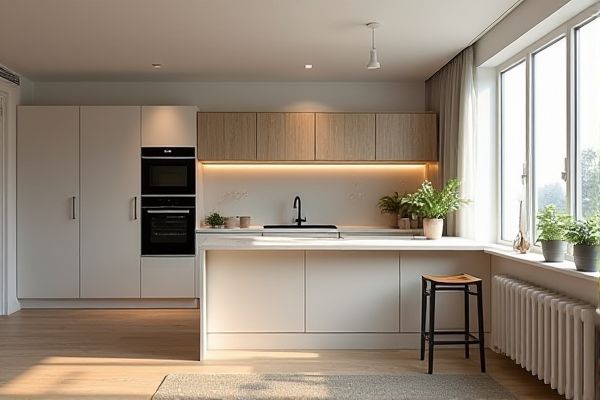
Maximizing your storage efficiency requires a clear understanding of counter space and hanging space, as each serves unique purposes for organizing your home or office. Explore the rest of the article to discover how to balance these two storage solutions effectively for your needs.
Table of Comparison
| Feature | Counter Space | Hanging Space |
|---|---|---|
| Primary Use | Surface area for tasks, placing items, or food preparation. | Storage area for hanging clothes, bags, or other items. |
| Location | Usually found in kitchens, bathrooms, workspaces. | Closets, wardrobes, entryways, and laundry rooms. |
| Space Efficiency | Requires flat, horizontal space; can limit workspace if cluttered. | Utilizes vertical space; maximizes storage in compact areas. |
| Accessibility | Items are easily reachable and visible on the surface. | Items may require hanging and removal; visibility depends on arrangement. |
| Best For | Kitchenware, tools, electronics, and daily-use items. | Clothing, coats, bags, accessories. |
| Maintenance | Needs regular clearing to maintain functionality. | Requires organization to avoid clutter and tangling. |
Understanding Counter Space and Hanging Space
Counter space refers to flat surfaces in your kitchen or workspace designed for food preparation, appliance placement, and other daily tasks, maximizing efficiency and organization. Hanging space involves vertical storage solutions such as hooks, racks, or wall-mounted organizers that free up counters by keeping utensils, pots, and tools within easy reach. Balancing your counter space and hanging space effectively enhances your room's functionality while maintaining a tidy, clutter-free environment for your activities.
Importance of Efficient Kitchen Storage
Maximizing counter space enhances meal preparation efficiency, while ample hanging space optimizes kitchen organization by keeping utensils and cookware accessible. Efficient kitchen storage balances these elements to reduce clutter and improve workflow. Prioritizing both ensures a functional and visually appealing cooking environment.
Pros and Cons of Counter Space
Counter space offers ample room for meal preparation, small appliances, and organizing kitchen essentials, enhancing your cooking efficiency and convenience. However, it can limit available storage options, often reducing the space for cabinets or hanging solutions, resulting in potential clutter or restricted vertical organization. Choosing the right balance depends on your kitchen size, cooking habits, and need for accessible surfaces versus storage capacity.
Advantages of Hanging Space Solutions
Hanging space solutions maximize vertical storage, freeing up valuable counter space for food preparation and small appliances. These systems enhance organization by keeping pots, pans, and utensils easily accessible, reducing clutter and improving kitchen workflow. Your kitchen benefits from increased efficiency and a visually appealing, open environment through strategic hanging space integration.
Space-Saving Tips for Small Kitchens
Maximizing counter space in small kitchens enhances meal prep efficiency and reduces clutter, making the environment more functional. Utilizing vertical hanging space with racks and magnetic strips keeps essential tools within reach while freeing up valuable countertop areas. Space-saving solutions like multi-tier shelving and foldable racks optimize both counter and hanging storage, transforming tight kitchens into organized, practical workspaces.
Popular Hanging Storage Ideas
Maximize your kitchen's efficiency by incorporating popular hanging storage ideas such as wall-mounted pot racks, pegboards, and overhead rails for utensils and pans. These solutions free up valuable counter space, keeping your cooking area clutter-free while offering easy access to frequently used tools. Your kitchen benefits from enhanced organization and a stylish display that saves room without sacrificing functionality.
Maximizing Counter Space in Modern Homes
Maximizing counter space in modern homes enhances kitchen efficiency by providing ample room for meal preparation and small appliances. Installing wall-mounted shelves or hooks transforms hanging space into practical storage, freeing up valuable countertop areas. You can optimize your kitchen layout by balancing minimal hanging storage with expansive counters to create a clean, functional environment.
Balancing Aesthetics and Utility
Maximizing counter space enhances kitchen functionality by providing ample room for meal preparation and appliances, while ample hanging space keeps utensils and pots organized and easily accessible without cluttering surfaces. Balancing aesthetics and utility involves selecting sleek, minimalistic hanging racks that complement your kitchen design, ensuring visual harmony alongside practical storage solutions. Your space benefits most when countertop freedom is preserved for active use, and hanging options are strategically placed to maintain an open, clean environment.
Common Mistakes in Kitchen Organization
Many common mistakes in kitchen organization stem from prioritizing either counter space or hanging space without balancing the two, leading to cluttered surfaces or underutilized walls. Overloading counters with appliances reduces prep area, while excessive hanging storage can make the kitchen feel cramped and disrupt workflow. Optimizing your kitchen layout requires carefully allocating space for both counters and hanging units to enhance efficiency and maintain a clean, organized environment.
Choosing the Right Storage Solution for Your Needs
Counter space maximizes accessibility for frequently used items and food preparation, ideal for busy kitchens requiring efficiency. Hanging space optimizes vertical storage by freeing up countertops, perfect for kitchens with limited surface area or for organizing pots, pans, and utensils. Selecting between counter and hanging storage depends on kitchen size, workflow preferences, and specific storage needs to create a functional and clutter-free environment.
 homyna.com
homyna.com